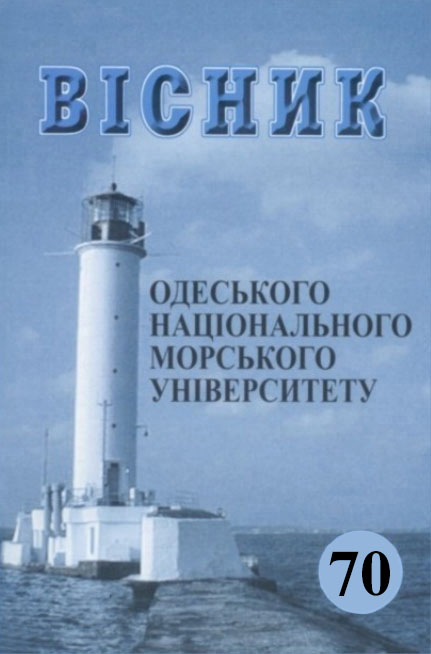Analysis of the current state in development of the thruster unit «screw propeller-nozzle» with optimal hydrodynamic qualities
Main Article Content
Abstract
Application of propulsive nozzles is a well-known way to improve efficiency of ship propulsion. Ducted propellers are advantageous for all ships with low advance caefficients of propellers caused by increased unit design loading. An analysis of hydrodynamic phenomena accompanying operation of the modern thruster units and their effect on propulsion efficiency has been performed. Principal geometric parameters of the thruster units, which affect their hydrodynamic qualities, have been submitted. Effects of a gap between blade tips and inner surface of the nozzle on tip losses, and of a ratio between diameters of narrowest and outlet nozzle cross-sections on the unit efficiency have been considered. Approaches to designing ducted propellers have been described. Design methods are based on the mathematical model of ideal thruster, the lifting-line theory of propellers, the experimental results obtained in ship model basins and water tunnels, on computational fluid dynamics. Specially developed propellers with wide blade tips (Ka series) have been analyzed. The comparison of efficiency showed no evident advantage of them over a normal propeller installed in nozzle. Their features can be explained rather by considerations of reliability and manufacturability. The main drawbacks, removal of which can be considered as significant improvement of the thruster unit, have been identified. Promising directions of development, such as wake- adapted nozzles with non-axisymmetric profiling and propellers with curved stacking lines of blades for hydrodynamic unloading of tip-region have been considered. Methods of boundary layer control applied to flow over inner outlet surfaces of nozzles have been considered as another promising direction. Conventional approaches to efficiency improvement, which can be applied to both isolated and ducted propellers, have been mentioned as well.
Article Details
References
2. van Lammeren, W.P.A., Troost L. & Koning J.G. Resistance, propulsion and steering of ship: A manual for designing hull forms, propeller and rudders. Haarlem, Holland: H. Stam., 1948. – 366 P.
3. Kerwin J.E. & Hadler J.B. Paulling J.R. (Ed.). Propulsion. Jersey City, USA: SNAME, 2010. – 79 P.
4. Basin A.M., Anfimov V.N. Gidrodinamika sudna: soprotivlenie vodyi, dvizhiteli, upravlyaemost i kachka [Ship hydrodynamics: water resistance, thrusters, maneuverability and motions]. – L.: Rechnoy transport [River transport], 1961. – 684 P. (in Russian).
5. Guyon E., Hulin J.-P., Petit L., Mitescu C.D. Physical Hydrodynamics. – Oxford University Press, 2001. – 505 P.
6. Voytkunskiy Ya.I., Pershits R.Ya., Titov I.A. Spravochnik po teorii korablya [Handbook on theory of ships]. L.: Sudostroenie [Shipbuilding], 1973. – 512 P. (in Russian).
7. Chang P. Separation of Flow. Volume 1. Moskva. Izdatelstvo «Mir», 1972. – 300 P. (in Russian).
8. Prandtl L. Gidroaeromehanika [Hydroaerodynamics]. Izhevsk: NITs «Regulyarnaya i haoticheskaya dinamika», 2000. – 574 P. (in Russian).
9. OST 5.4129-75. Kompleks dvizhitelnyiy «grebnoy vint – napravlyayuschaya nasadka». Metodika rascheta i pravila proektirovaniya [Thruster unit «screw propeller – propulsive nozzle». Method of calculation and rules of design]. – Vved. 1975-07-01. – M.: Izd-vo standartov [Publishing house of standards], 1975. – 202 P. (in Russian).
10. Oosterveld M.W.C. Wake adapted ducted propellers). Wageningen, the Netherlands: Netherlands Ship Model Basin. – 1970. – No. 345.
11. Pechenyuk A.V., Stecyuk T. (2021) Analiz konstruktyvnykh osoblyvostei hrebnoho hvyntu, pryznachenoho do roboty u napravliaiuchii nasadtsi [Analysis of design features of marine propeller intended to function in pro- pulsive nozzle]. Suchasni tekhnolohii proiektuvannia, pobudovy, yekspluata- tsii i remontu suden, morskykh tekhnichnykh zasobiv i inzhenernykh sporud: materialy Vseukr. nauk.-tekhn.konf. z mizhnar. uch., m. Mykolaiv, 183-187.
12. Koronowicz T., Krzemianowski Z., Tuszkowska T., Szantyr J. A. (2009). A complete design of ducted propellers using the new computer system. Polish maritime research, 2, 34-39.
13. Togunyants A.R., Vishnevskiy L.I., Krasavtsev V.E. (2009). Vyibor formyi lopasti grebnogo vinta kak sredstva resheniya gidrodinamicheskih zadach [Choice of blade contour shape of screw propellers as a means to solve hydrodynamic problems]. Morskoy vestnik, 3 (31), 101-105 (in Russian).
14. Rice speed nozzle: веб-сайт. URL: http://ricefoundries.com/
15. Veretennikov S.V. Snizhenie gidravlicheskih poter v otryivnom diffuzore kameryi sgoraniya gazoturbinnogo dvigatelya putem upravleniya pogranich- nyim sloem [Reduction of hydraulic losses in separative diffusers of combu- stion chambers of gas turbine engines by means of boundary layer control]: avtoref. dis. … kand. teh. nauk: 05.04.12 Sankt-Peterburg. – 2008. – 16 P. (in Russian).
16. Nozzle Cooling: веб-сайт. URL: https://www.damenmc.com
17. Carlton J. Marine propellers and propulsion. – 2nd ed. – Oxford (UK), Butterworth-Heinemann, 2007. – 560 P.
18. Breslin J.P., Andersen P. Hydrodynamics of ship propellers, – 1996. – 560 P.
